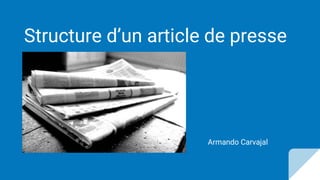
Structure_dun_article_de_presse_2022_.pptx
- 1. Structure d’un article de presse Armando Carvajal
- 2. Quelques conseils pour bien rédiger un article Le sujet de l’article Le traitement de l’information Le style de l’article Le plan L’accroche La relecture
- 3. Le sujet de l’article Il faut sélectionner une bonne information : avoir des témoignages, des chiffres fiables et répondre aux cinq questions de référence : Qui, quand, comment, où, quoi, pourquoi
- 4. Le traitement de l’information Pour écrire un article intéressant, il faut analyser le contenu et le mettre en valeur par une écriture claire, précise et soignée. La première phrase doit donner envie de continuer. Utilisez les expressions, les images, les anecdotes les plus " parlantes ". Ajoutez des images (photos, caricatures, schémas, dessins...) pour illustrer son propos.
- 5. Le style de l’article Selon le sujet et la façon dont vous voulez l’aborder, on peut choisir un ton : sensible, grave, léger, humoristique ou pédagogique. Utilisez des phrases courtes et incisives (sujet, verbe, compléments), choisissez des mots simples et concrets. Utilisez des points et des virgules et utilisez les mots de liaison (en effet, car, mais, pourtant, aussi, donc…). Privilégiez le temps présent. Votre article doit être clair, facile à comprendre.
- 6. Le plan Le plan doit être simple et logique. Le premier paragraphe est l’accroche : il donne généralement l’information la plus importante. Les autres paragraphes doivent suivre cette règle simple : une idée importante par paragraphe et ils doivent avoir une succession logique entre chacun. Sautez une ligne à chaque fin de partie.
- 7. L’accroche Elle donne envie au lecteur de lire l’article. Et pour attirer vos lecteurs : vous pouvez donner des chiffres précis, raconter une anecdote pour éveiller la curiosité du lecteur.
- 8. La relecture Relisez attentivement vos articles, partez à la chasse aux mots inutiles… et aux fautes d’orthographe ! Lisez et ré-écrivez votre projet d’article à la recherche des mots qui n’apportent rien. Faites relire par un ami.
- 9. La composition de l’article de presse La rubrique Le chapeau L’auteur de l’article Une Image/ photo La légende Le titre
- 10. Glossaire Brève : un texte court, une "nouvelle brève" (dix lignes maximum). Elle donne en trois ou quatre phrases une information très concise, sans titre, qui répond obligatoirement aux questions: qui, quoi, quand, où, et parfois comment et pourquoi. Chapeau : Texte d’introduction d’un article, généralement présenté en caractères gras. Il concentre en quelques lignes l’essentiel de l’information.
- 11. Glossaire Légende : Court texte accompagnant une photo ou un dessin et visant à lui donner un sens. Une légende peut être descriptive, interprétative, informative. Elle doit être accompagnée du crédit photo (nom du photographe, de l’agence). Photo : Elle vise à accrocher le regard du lecteur, à retenir son attention, à donner plus de force à une information. Source : L’origine de l’information (l’auteur, la ressource, le document).
- 12. Merci pour votre attention !